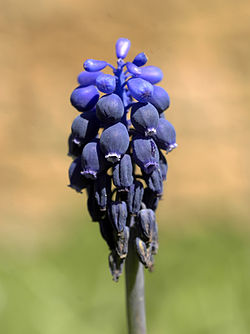From Wikipedia
Open on Wikipedia
| Grape hyacinth | |
|---|---|

| |
| Scientific classification | |
| Kingdom: | Plantae |
| Clade: | Tracheophytes |
| Clade: | Angiosperms |
| Clade: | Monocots |
| Order: | Asparagales |
| Family: | Asparagaceae |
| Subfamily: | Scilloideae |
| Genus: | Muscari |
| Subgenus: | Muscari subg. Muscari |
| Species: | M. neglectum
|
| Binomial name | |
| Muscari neglectum | |
| Synonyms[1] | |
|
Synonymy
| |
Muscari neglectum is a perennial bulbous flowering plant in the asparagus family Asparagaceae. Members of this genus are commonly known as grape hyacinths, and M. neglectum is known as common grape hyacinth[2] or starch grape hyacinth.[3] Muscari are perennial bulbous plants native to Eurasia. They produce spikes of dense, commonly blue, urn-shaped flowers. It is sometimes grown as an ornamental plant, for example, in temperate climates as a spring bulb.
Description
[edit]Muscari neglectum is a herbaceous plant growing from a bulb. The flower stems are 5–20 cm tall. The flowers are arranged in a spike or raceme and are dark blue with white lobes at their tips (teeth); there may be a cluster of paler sterile flowers at the top of the spike.[4] The raceme is 2–6 cm long. The fruit is a 3-celled capsule with two ovules in each cell.[5]
It is a very well known species in cultivation (being described as the "common" grape hyacinth by Brian Mathew);[4] it increases rapidly and can become invasive.
Range
[edit]The native range of Muscari neglectum extends around the Mediterranean basin including North Africa, Southern Europe, and Western Asia, and to Central Europe, Ukraine, European Russia, the Caucasus, Iran, Afghanistan, Pakistan, and Central Asia.[1]
Taxonomy
[edit]The name was attributed to Giovanni Gussone by Michele Tenore in a list of plants of the Neapolitan area published in 1842. The species has a confused nomenclatural history; Plants of the World Online lists 51 taxonomic synonyms.[1] The name M. racemosum is commonly found as a synonym for M. neglectum in the horticultural literature,[6] although the true M. racemosum Mill. is a different species.[7]
References
[edit]- ^ a b c "Muscari neglectum Guss. ex Ten. & Sangiov". Plants of the World Online. Royal Botanic Gardens, Kew. Retrieved 4 September 2025.
- ^ Grey-Wilson, Christopher; Mathew, Brian & Blamey, Marjorie (1981), Bulbs : the bulbous plants of Europe and their allies, London: Collins, ISBN 978-0-00-219211-8, p. 114
- ^ NRCS. "Muscari neglectum". PLANTS Database. United States Department of Agriculture (USDA). Retrieved 15 July 2015.
- ^ a b Mathew, Brian (1987), The Smaller Bulbs, London: B.T. Batsford, ISBN 978-0-7134-4922-8, p. 127
- ^ Cullen, James; Knees, Sabina G.; Cubey, H. Suzanne (2011). The European Garden Flora Flowering Plants: A Manual for the Identification of Plants Cultivated in Europe, Both Out-of-Doors and Under Glass. The Cambridge University Press. p. 124. ISBN 978-0521761475.
- ^ See, e.g., Mathew 1987, p. 127
- ^ WCSP (2011), World Checklist of Selected Plant Families, The Board of Trustees of the Royal Botanic Gardens, Kew, retrieved 2011-11-14, search for "Muscari racemosum"